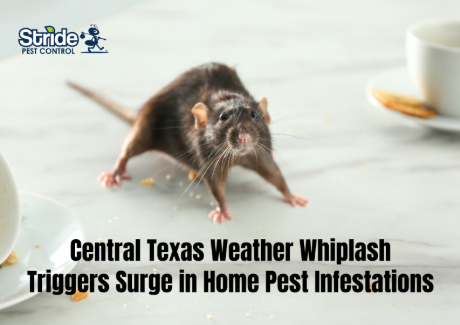
Only in Central Texas can we spend a sunny weekend enjoying 90°F heat, then suddenly wake up to freezing mornings that feel straight out of winter. This week’s powerful cold front is expected to drop temperatures from near-record highs into the 50s with wind chills in the 20s, according to KXAN’s First Warning Weather Team.
It’s a dramatic shift that has many homeowners scrambling to adjust their thermostats and wardrobes. But while we’re layering up, another group is reacting just as quickly to the sudden chill: pests, especially rodents.
As outdoor conditions change overnight, rats and mice are already on the move, seeking shelter in the warmest and coziest place they can find in your home.
The Cold Front Effect: Why Weather Swings Send Rodents Indoors
Rodents are incredibly sensitive to temperature changes. When a warm spell abruptly gives way to cold air, their instincts kick in, driving them to find shelter fast. This behavior is part of their “overwintering” process, a natural survival mechanism that helps them endure harsh weather conditions.
Unlike insects that can slow their metabolism or go dormant, rodents remain active year-round. That means when the weather drops, they don’t hibernate, they relocate. And unfortunately, your attic, garage, or pantry provides everything they’re looking for: warmth, food, and nesting material.
Here’s what makes them so quick to invade:
- Thermal sensitivity: Rodents can detect temperature drops through specialized sensory whiskers and thermoreceptors. A sudden cold snap alerts them that survival outdoors is no longer possible.
- High adaptability: Rats and mice are agile climbers and contortionists. They can squeeze through holes as small as a dime and chew through materials like wood, insulation, and even soft metals.
- Dependence on stable shelter: Once they find a warm hiding spot, they tend to stay put, breeding rapidly and expanding their territory within walls, basements, or attics.
So while that cozy blanket might be keeping you warm, rodents are finding their own version of comfort inside your home’s hidden corners.
Why Central Texas Homes Are at High Risk
Our region’s unique mix of weather, construction styles, and landscapes makes it an ideal environment for rodent infestations during sudden temperature drops.
- Older limestone homes in Austin often have small gaps or cracks in foundations that act as perfect entry points.
- Suburban neighborhoods in San Antonio are surrounded by greenbelts, creeks, and brushy areas where rodents naturally thrive. When cold hits, they move from those outdoor habitats straight into nearby homes.
- The Hill Country’s rocky terrain provides natural shelter for rodents, but when the ground gets too cold, they seek man-made warmth.
Adding to the challenge are the strong north winds predicted this weekend, gusting up to 40–45 mph. Those winds create air pressure that can actually pull outside air (and pests) through even the smallest gaps in doors, vents, and siding. Once they’re inside, the real problems begin.
The Hidden Dangers of Rodent Infestations
A few scratching sounds at night might not seem alarming at first, but rodent activity can escalate fast. Beyond being a nuisance, they pose several serious risks:
- Property Damage: Mice and rats chew on anything to keep their ever-growing teeth trimmed, including electrical wires, insulation, and wood beams. This can lead to costly repairs and even fire hazards.
- Contamination: Rodent droppings, urine, and hair can contaminate food and surfaces, spreading diseases such as salmonella, hantavirus, and leptospirosis.
- Odor and Air Quality Issues: Once nesting begins, droppings accumulate and release ammonia-like smells that linger in closed spaces like attics or basements.
- Rapid Reproduction: A single pair of mice can produce dozens of offspring in just a few months. By the time you notice them, you may already have an infestation.
Other Pests Following the Cold
Rodents may be the main invaders during a freeze, but they’re not alone. The sudden temperature plunge also drives other pests indoors:
- Cockroaches and crickets sneak into kitchens and bathrooms seeking warmth and moisture.
- Spiders follow prey insects into dark corners, basements, and garages.
- Scorpions around San Antonio often crawl under baseboards and into garages to escape the cold limestone ground.
Each of these pests reacts differently to weather changes, but they all share one goal: finding a warm, stable environment. That’s why even a brief cold spell can trigger multiple infestations at once.
Don’t Wait Until It’s Too Late
Central Texas weather is unpredictable, we might see another round of sunshine soon, followed by another freeze. But one thing is certain: rodents won’t leave once they’re comfortable inside.
The key to staying pest-free this winter is early prevention and expert inspection.
At Stride Pest Control, our licensed technicians specialize in identifying how temperature shifts affect pest behavior in Austin, San Antonio, and surrounding areas. We don’t just treat infestations, we help prevent them through thorough inspections, sealing strategies, and customized solutions.
Whether you’re in Austin, San Antonio, or anywhere in between, our team is ready to keep your home protected, warm, and pest-free.
👉 Schedule your free inspection today before the next cold front hits and keep your home cozy for your family, not for rodents.

